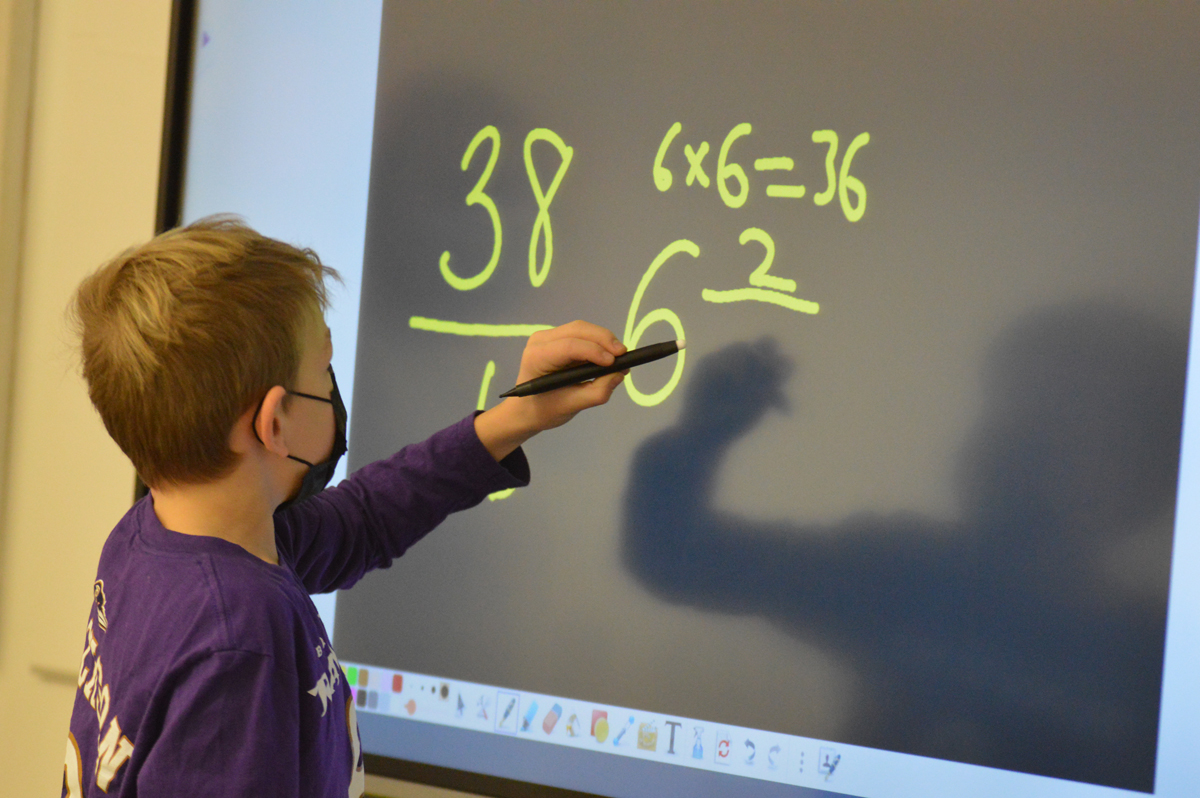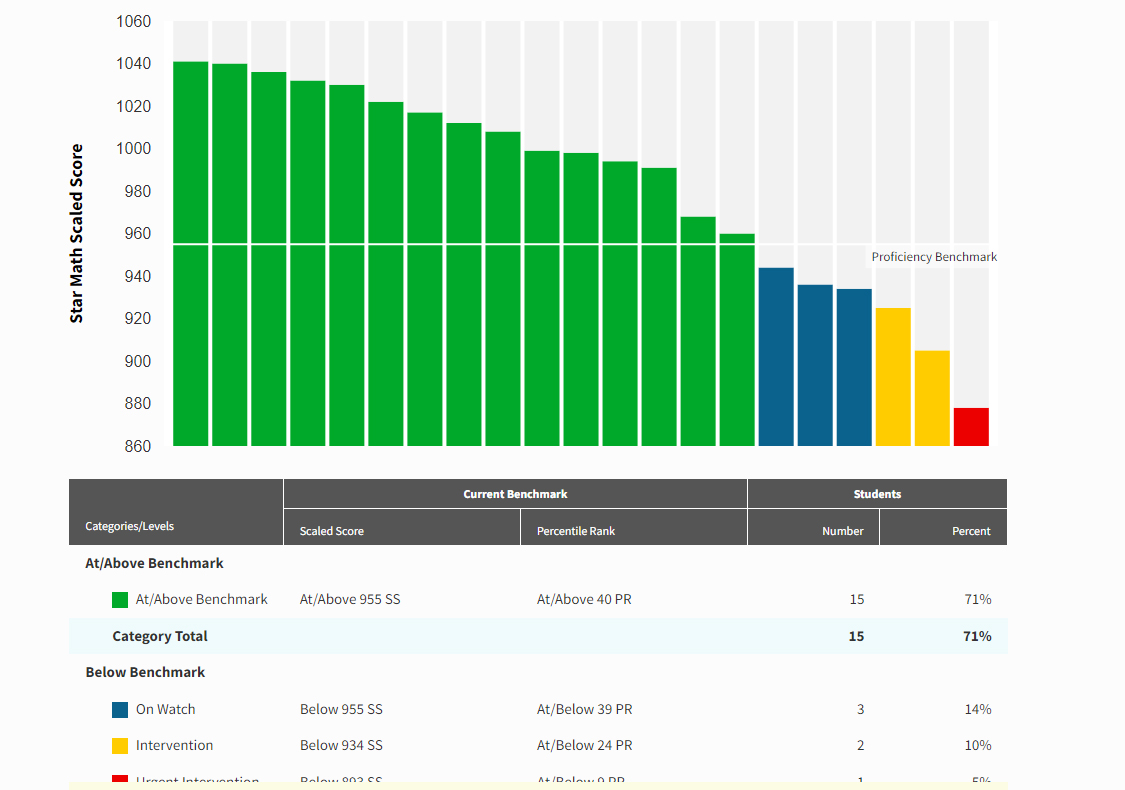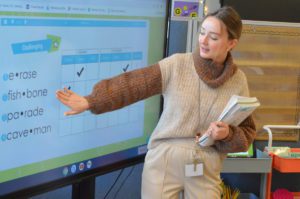
A student solves a math problem at Red Mill Elementary School earlier this winter.
East Greenbush Central School District elementary students are showing impressive growth in reading and math according to data shared at a public Board of Education meeting earlier this month.
Based on results from the district’s universal screener, a computer adaptive test that students took at the start of the school year and then again this winter, students reading at or above grade level has increased 37.5% for grades K-2 and 13% for grades 3-5. Additionally, students learning at or above grade level for math has increased 17.6%.
This growth has been achieved through the efforts of classroom teachers, Academic Intervention Services teachers and the new Response to Intervention (RTI) Coordinator and K-3 Intervention Specialists as they have implemented a new universal screener.
Universal Screener Sets Foundation for Learning Growth

Genet 5th Grade Teacher Sarah Murawski teaching an ELA lesson.
The district purchased Renaissance Star Assessments with federal COVID relief funds this past summer as a way to evaluate achievement in reading, math and early literacy. The software program allows teachers and staff to identify what skills students are ready to learn, provide interventions that students need and track progress toward academic targets.
“These impressive growth scores are a testament to our multi-tiered system of support,” said RTI Coordinator Lisa Mahar, who oversees the Renaissance Star program. “We are beginning to see the benefits that come with having this universal screening tool.
“Renaissance Star allows us to not only identify a student’s focus skills in both reading and mathematics, but it also tracks student growth throughout the year with a consistent measure,” she continued. “We can now use the Star data to make the necessary changes to our instruction to meet the students’ needs and continue to make academic growth to close any achievement gaps.”
For classroom teachers, having this new tool has been empowering because it provides them with data for each student and what they know in a particular subject. The reports are color-coded to illustrate achievement for each of the learning standards related to the given benchmark.
Red Mill 4th Grade Teacher Misty Hayes knew she would need to delve deeper into geometry with her students when that unit began because the Star Math report showed students scored low in that subject on the fall screener. By focusing more on that unit, she was able to improve her students’ scores.
Overall, her students improved from 71% At/Above grade level in math in the fall to 95% At/Above grade level in the winter.

Screenshot of a Star Math report for students in Misty Hayes’ class at Red Mill Elementary School based on the fall screener. The data shows 71% of the students were At/Above benchmark. Her class improved to 95% At/Above benchmark on the winter screener just a few months later.
“Assessments like Renaissance, which provide a means to analyze student performance, offer evidence that can play a critical role in my classroom,” said Mrs. Hayes. “The data collected has already helped me make informed decisions and has guided me in my instructional choices that support all students as they work towards proficiency in their learning targets. My goal is to aim for maximum individual growth, and a program like this provides me with data to do so.”
Intervention Specialists Provide Targeted Support

K-3 Intervention Specialist Megan Kenney teaching a small group lesson at Green Meadow Elementary School.
The district supported students and classroom teachers by hiring 10 new intervention specialists, also from COVID relief funding, who focus on reading and math help. Most students who receive intervention services meet in small groups of 2-4 students with a K-3 Intervention Specialist daily. They work on reading and math for 30 minutes in addition to their regular instruction in ELA/Early Literacy and Math.
Throughout the school year, teachers and intervention specialists have also engaged in professional development and had access to innovative instructional resources.
“Transitioning to Renaissance Star assessments has significantly reduced the amount of time needed to test, compile and analyze our students’ academic data,” said James McHugh, Assistant Superintendent for Curriculum and Instruction. “This accomplished our goal of actually increasing the amount of instructional time teachers spend providing targeted instruction to our students in both ELA and mathematics. The assessment data has allowed us to assign faculty based on demonstrated need to best ensure that our students who require additional academic support are receiving it.”
Expansion to Goff Middle School
Due to the success of the program, the district is expanding its use of Renaissance Star Assessments and will implement it at Howard L. Goff Middle School in the fall. Earlier this winter, 6th and 7th grade teachers in ELA, Math and AIS were trained on Renaissance Star Assessments and students took practice tests to provide an authentic experience with the assessment.
Adding the universal screener to Goff next year will provide a common screening tool and a consistent measure of academic achievement from elementary school through middle school.
“Coming off the challenges associated with the pandemic on our students, we planned to enter the 2021-22 school year with a strategy to do all that we could to assess student growth and to provide targeted support to catch kids up to grade level in the early elementary grades,” said Superintendent Jeff Simons. “I am pleased that the data is showing impressive growth.”
Renaissance Star Data
Star Early Literacy
Reading assessment for students in Grades K-2
| % of Students At or Above Grade Level | |||
| Fall Assessment | Winter Assessment | Change | |
| East Greenbush CSD | 48 | 66 | +18 (37.5% increase) |
Star Reading
Reading assessment for students in Grades 3-5
| % of Students At or Above Grade Level | |||
| Fall Assessment | Winter Assessment | Change | |
| East Greenbush CSD | 69 | 78 | +9 (13.0% increase) |
Star Math
Math assessment for students in Grades K-5
| % of Students At or Above Grade Level | |||
| Fall Assessment | Winter Assessment | Change | |
| East Greenbush CSD | 68 | 80 | +12 (17.6% increase) |
